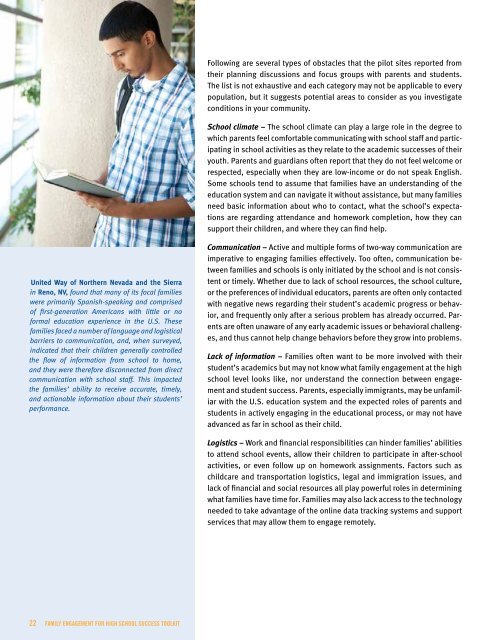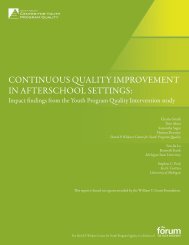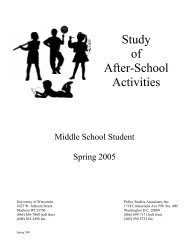View PDF
View PDF
View PDF
- No tags were found...
You also want an ePaper? Increase the reach of your titles
YUMPU automatically turns print PDFs into web optimized ePapers that Google loves.
Following are several types of obstacles that the pilot sites reported fromtheir planning discussions and focus groups with parents and students.The list is not exhaustive and each category may not be applicable to everypopulation, but it suggests potential areas to consider as you investigateconditions in your community.School climate – The school climate can play a large role in the degree towhich parents feel comfortable communicating with school staff and participatingin school activities as they relate to the academic successes of theiryouth. Parents and guardians often report that they do not feel welcome orrespected, especially when they are low-income or do not speak English.Some schools tend to assume that families have an understanding of theeducation system and can navigate it without assistance, but many familiesneed basic information about who to contact, what the school’s expectationsare regarding attendance and homework completion, how they cansupport their children, and where they can find help.United Way of Northern Nevada and the Sierrain Reno, NV, found that many of its focal familieswere primarily Spanish-speaking and comprisedof first-generation Americans with little or noformal education experience in the U.S. Thesefamilies faced a number of language and logisticalbarriers to communication, and, when surveyed,indicated that their children generally controlledthe flow of information from school to home,and they were therefore disconnected from directcommunication with school staff. This impactedthe families’ ability to receive accurate, timely,and actionable information about their students’performance.Communication – Active and multiple forms of two-way communication areimperative to engaging families effectively. Too often, communication betweenfamilies and schools is only initiated by the school and is not consistentor timely. Whether due to lack of school resources, the school culture,or the preferences of individual educators, parents are often only contactedwith negative news regarding their student’s academic progress or behavior,and frequently only after a serious problem has already occurred. Parentsare often unaware of any early academic issues or behavioral challenges,and thus cannot help change behaviors before they grow into problems.Lack of information – Families often want to be more involved with theirstudent’s academics but may not know what family engagement at the highschool level looks like, nor understand the connection between engagementand student success. Parents, especially immigrants, may be unfamiliarwith the U.S. education system and the expected roles of parents andstudents in actively engaging in the educational process, or may not haveadvanced as far in school as their child.Logistics – Work and financial responsibilities can hinder families’ abilitiesto attend school events, allow their children to participate in after-schoolactivities, or even follow up on homework assignments. Factors such aschildcare and transportation logistics, legal and immigration issues, andlack of financial and social resources all play powerful roles in determiningwhat families have time for. Families may also lack access to the technologyneeded to take advantage of the online data tracking systems and supportservices that may allow them to engage remotely.22 Family Engagement for High School success Toolkit








